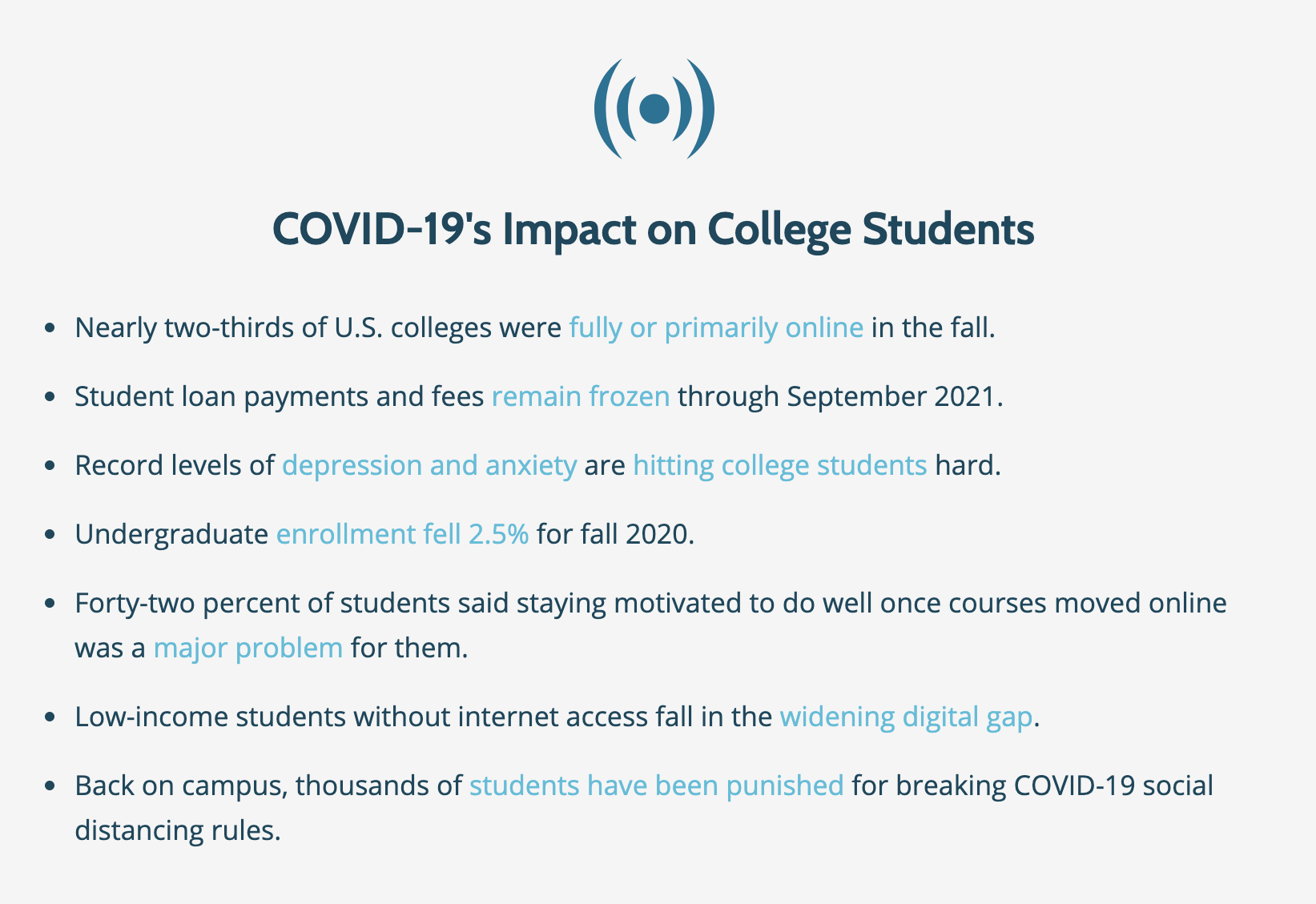The pandemic has changed higher education
The pandemic has changed higher education in many ways. On March 6 of 2020 “The University of Washington in Seattle became the first major American college to shut down campus. Ten days later, over 250 U.S. colleges and universities followed suit.” Most campuses are still not fully functioning yet. Most have allowed students to return on campus but are continuing most instruction online. Others have encouraged students to stay home. The end of the third-semester post-shutdown is approaching and everyone is wondering what will happen next. Neither colleges nor students were prepared for extended campus closures. Both face a variety of challenges going forward. Due to various coronavirus outbreaks, some institutions have already been forced to a second closure.
Remote learning
The biggest challenge for many students has been the switch from in-person to remote learning. In fact, “nearly two-thirds of U.S. colleges were fully or primarily online” in the Fall ‘20 semester. Remote learning has probably been one of the biggest ways that the pandemic has changed the higher education system. While nearly 88% of Americans are internet users, the share of Americans with computers hovers around 74%, according to Statista. Smartphones can only get you so far. They aren’t ideal for video conferences, online quizzes, and essay-writing. Some of the initial challenges for students learning remotely have gotten better with time. Initially, teachers had only days to move their classes online so it took a while for them to figure out the technology. Now, they are better prepared in many cases. Their students are more likely to have a higher quality experience.
Ways The Pandemic Will Change Higher Education Forever
USA Today’s article “5 ways COVID-19 will change higher education forever, and how colleges can adapt” by Adam Weinberg has some points. It explains how the pandemic has changed higher education and how colleges can adapt in the future.
Demonstrated Value
Higher Education and Cost Concerns
Students and their parents pay more attention to the value they receive from higher education as well as the costs. As more families either cannot or won’t pay the levels of tuition, concerns may grow. Families want to make sure the investment of time and financial resources are worth it. Colleges and universities will be forced to be more reflective. They’ll be reflective regarding the quality a particular institution offers and what families will pay for that perceived value.
Education on Demand
College Students Adapting to Change
Today’s prospective students are not confined by what we have historically offered or how we have offered it. They want education when they want it and how they want it. They are much more open to online and in-person hybrid formats.
Long-term Security is the Key Goal
Students Focus on Life Launch
We tend to reduce this to “getting a job,” but this misses the larger and more challenging point. Both parents and students go to college because they want to do well in life. Going forward, both parents and students will want to know how successful the university is. They want to know how well graduates can be launched into lives and careers. They also will want to know more about the risk factor. This means, the percent of students who fall through the cracks and how the college helps those students and alumni.
Location Matters More Than Ever
Higher Education and Location Concerns
It is expected that location will be one of the big deciding factors in influencing college choice. Some students will choose to stay closer to home given the uncertainty of the pandemic. International students will select areas of the country that are open and friendly to people like themselves. More students attending college are attentive to their own needs. These needs could be health-related, focused on entertainment, or maybe access to transportation. Students will choose where to study and live with those factors in mind.
The Future of Higher Education
The sudden switch to online classes has caused anxiety and raised questions among students about their academic futures. The long-term effects are hard to tell. Generally speaking, when vulnerable populations are hit by an emergency, it makes their life situation worse. So, “overall that’s what we are going to see…”(Eddy Conroy of Hope Research Center for College, Community & Justice). He also says that “the worse thing is that we could see a lot of students who are right on the tipping point.” He is referring to students who are thinking of maybe leaving college leave and not come back. For many students, the pandemic was the emergency that tipped them over the edge.
“Initially I was really excited because I didn’t think it was that serious…but as time has gone on and now that we’re fully doing classes without being in class, it’s a lot harder than I thought”
“I’m not super satisfied…there has been a push to lower tuition just because classes are going to be taught online but [my] university has said that tuition will not change.”
“The thing that’s the hardest is not having students face to face, I’ve been teaching for 35 years and I’ve never taught in an online situation”…
“I think the professors so far have been really good at saying this is the challenge and this is the new medium that we have to work with. Not only how do we cope with that but how do we take advantage of that.”
“We just need to remember that we aren’t the only ones, and it’s temporary convenience, we’ll push through and we’ll be okay”
ABOUT THE AUTHOR
Jada Pierce
Student Author - Spring 2021







